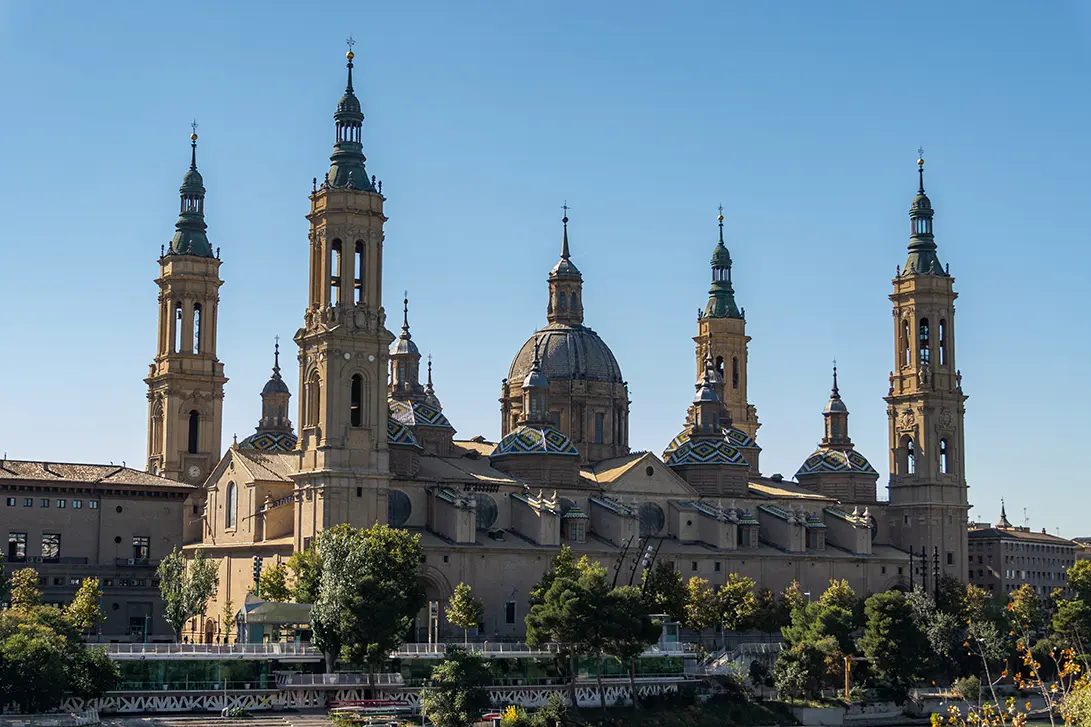
Many people are aware of the devotion to St. James the Greater in Santiago de Compostela, Spain. Thousands of pilgrims walk from points all over Europe to venerate his resting place. What many pilgrims might not know is that there is another site of devotion related to this saint in another part of Spain – the Shrine to Our Lady of the Pillar in Zaragoza.
In the year 40, St. James, during his mission to people in what is now Spain, was praying for help in the work of evangelization. He was growing discouraged in his work and worried over the success of his work. Tradition holds that the Blessed Mother then appeared to him to strengthen and reassure him. She showed him a column upon which a statue of herself holding the Child Jesus stood, and instructed St. James to build a shrine to her on that spot.
And so the first church in history dedicated to Our Lady was built and one remains until this day in the same spot. The pillar and statue erected nearly 2,000 years ago show no signs of the wear and tear of the centuries even through years of invasions, wars, famine and plague.
The initial chapel, built by St. James himself stood only sixteen feet long by eight feet wide – large enough to house the pillar and statue and provide a small space for worship. Through the generous offerings of pilgrims who visited the shrine, a large church was built that lasted until the end of the seventeenth century. The cornerstone of the new church was laid in 1686 on the feast of St. James.
The current church was completed in the 18th century and although two bombs were dropped on it during the Spanish Civil War, none of them exploded, and the diffused bombs are kept on display on the grounds of the church as a reminder of this miraculous preservation. Zaragozans are highly devoted to Our Lady of the Pillar and her feast day – October 12 – is cause for a grand 9-day festival in the city.
Many Saints have pilgrimaged to the shrine throughout the centuries. St. John of the Cross, St. Teresa of Avila, and St. Ignatius of Loyola all made the journey to Zaragoza during their lifetime. St. Josemaria Escriva made daily 'pilgrimages' to pray for guidance and wisdom. His devotion is shared among the faithful today.
Fun Facts
- The Virgin Mary of Pilar is the Patron Saint of the Hispanidad (people and communities who share the Spanish language and have cultures that can be traced back to Spain)
- The feast of the Virgin of the Pilar is also the national holiday of Spain, often called Día de la Hispanidad. It is also known as Día de la Raza in some Spanish-speaking countries.
- This is the only recorded Marian apparition that occurred during the earthly life of our Blessed Mother.
- The name “Pilar” has been a popular name for baby girls in Spain throughout the past centuries.
- Although nearly 2,000 years old, the original statue shows no signs of deterioration and never needs to be dusted.
- Scientific studies of the pillar upon which the statue stands have shown that it is of a unique type of granite found nowhere else on early.
- The statue of the Virgin of Pilar is adorned with vestments that coincide with the liturgical celebrations and calendar of the Church.
- Zaragoza is located on the Camino Catalán, one of the many paths that traverse Europe and Spain, culminating at the burial site of St. James.
- Our Lady of Pilar was made patroness of the New World after the celebration of the first Mass celebrated there on her feast day, October 12, 1942.



